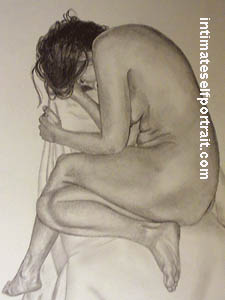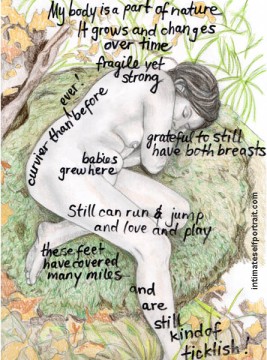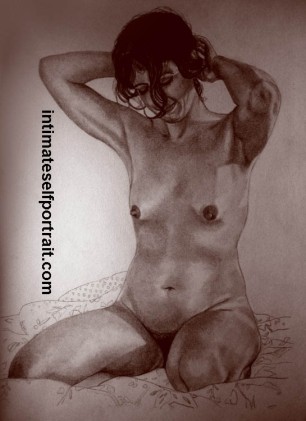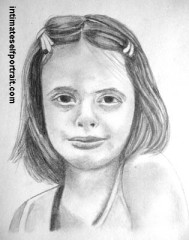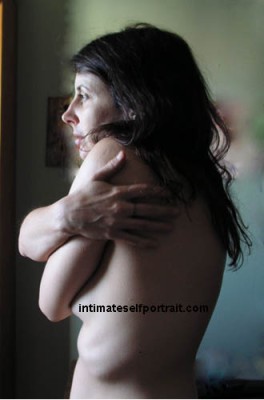
Is it Photoshopped? It IS! But only to hide some of the pictures on the wall behind my face. The rest is real, even the far-away look that says “YUCK” about showing myself to the camera, even alone in my room.
Is is narcissism? Vanity? Or a simple, accessible way to heal from self-rejection?
I do it because I have always judged and criticized myself harshly, and self-portraiture is the best process I have found to really change my vision. When I look in the mirror, it’s to check – criticize – correct – (and I can always find something to fix) in a never-ending quest for perfection.
I am 46 years old now and have been drawing myself for 10 years. I keep quitting and coming back to it, because in spite of my resistance, it works… it helps. This self-image-obsession has sucked so much vital energy from my life over the years that a part of me is really angry about it… but that anger just feeds the self-destructiveness of the mind.
Fortunately, the more constructive part of me that loves others easily is willing to look beyond the skewed vision of my mind to see something else… a perfectly imperfect yet strong woman with a still-vulnerable little girl inside, a worthy and yes, possibly even beautiful human being. AS ARE WE ALL…
It’s a double-edged sword in that it’s only because I want to be so outstandingly beautiful that I can possibly see myself as so pitifully ugly. And I’m not, even on the world’s terms, ugly. It’s craziness… but even crazier, our culture FEEDS this craziness!
I chose drawing because it was simple, accessible, free, and I had gentle, non-judgemental people around who encouraged me on this path even when I wanted to throw myself, them, or my drawings out the window. I am no longer shy to talk about this or show my work because I’ve had enough of falling back to the false visions and ingrained beliefs that are so harmful to my health and happiness.
 I will mostly share drawings on this blog – to describe the process and invite others to try it – but I posted the above photograph as a starting point because it expresses in one image how much I’ve struggled with shame and fought for self-acceptance. And, because photography was the foundation for the drawing practice.
I will mostly share drawings on this blog – to describe the process and invite others to try it – but I posted the above photograph as a starting point because it expresses in one image how much I’ve struggled with shame and fought for self-acceptance. And, because photography was the foundation for the drawing practice.
Being old enough to remember life before digital cameras, I must say they played a huge part in the development of this process because their accessibilty lessened the cost as well as the performance aspect of photography. My first digital camera allowed me simply to take many, many, pictures, period.
When I turned towards this work on self-image, for about three years I took a minimum of three pictures of myself EVERY single day and stored them in my computer. I didn’t even try to pose; most often I was balled up in shame, but over time I was able to experiment and slowly unfold my body. I eventually took some pictures of me dancing nude, which only I have ever seen because they were only taken for me to learn to love me.
To take self-portraits I used the timer, propping the camera up anywhere, on just about anything, and throwing myself out in front of the lens spontaneously as the seconds ticked down to the “click”. I didn’t worry about lighting or backgrounds or positioning, because the taking of the pictures was the process – it was not about the results. In my mind, the pictures were only for drawing purposes, so even if many of the photos were imperfect (not to mention unflattering), I kept them all, hoping to learn to accept myself from every angle. This process was a very private one for me, as I chose to be nude in the images, which probably accelerated the process by helping strip back the layers of shame to let something more real shine through.
But that was just the beginning – the most beautiful visions came through when I took up a pencil and slowly transformed the photographs into the simplest of drawings and later more detailed “artwork”. Because we’re all “works of art”… just the way we are, any other vision of ourselves is simply false.

